Kwanzaa, a seven-day holiday that celebrates African-American heritage, is the brainchild of Dr. Maulana Karenga, a professor of Africana Studies at California State University Long Beach. Karenga created Kwanzaa as a way to help African-Americans remember their roots and also to foster unity during a time of incredible racial strife. It's been observed from Dec. 26 to Jan. 1 every year since 1966.
Karenga, a controversial figure in the black power movement, openly opposed Christian beliefs and originally declared that Kwanzaa should be an anti-Christmas of sorts. By the late-1990s, though, he had backed off, saying "Kwanzaa was not created to give people an alternative to their own religion or religious holiday." Today, about one in seven African-Americans celebrates Kwanzaa, and many of them do it in addition to Christmas [sources: Raskin, Scholer].
Advertisement
The name Kwanzaa is derived from matunda ya kwanza, a Swahili phrase for "first fruits," is based on traditional African harvest festivals, combining customs from a number of different cultures. Each of the seven days represents one of the seven principles of Kwanzaa, or nguzo saba. There are also seven symbols of Kwanzaa, which celebrants display prominently in their homes throughout the holiday.
The colors of Kwanzaa are red, black and green -- the colors of the Pan-African flag, which symbolizes unity among African people all over the world. Black represents the people, red their blood and green the earth and the future.
Kwanzaa is, of course, a festive time; it has all the feasting and celebrating you'd expect from a weeklong holiday, but it's also an occasion for reflection, conversation, contemplation and camaraderie. And although it's a relatively young holiday, it has its fair share of very specific, detailed traditions. So, if you don't know your vibunzi from your mishumaa saba, this is a good place to start!
We'll start off with the foundation of Kwanzaa: the seven principles.

